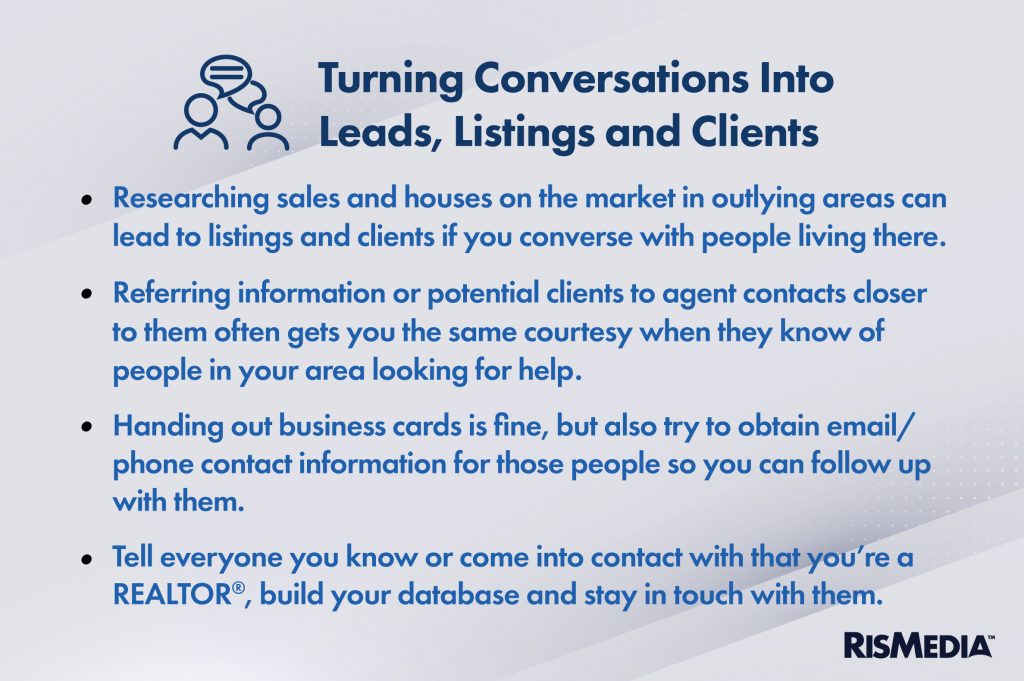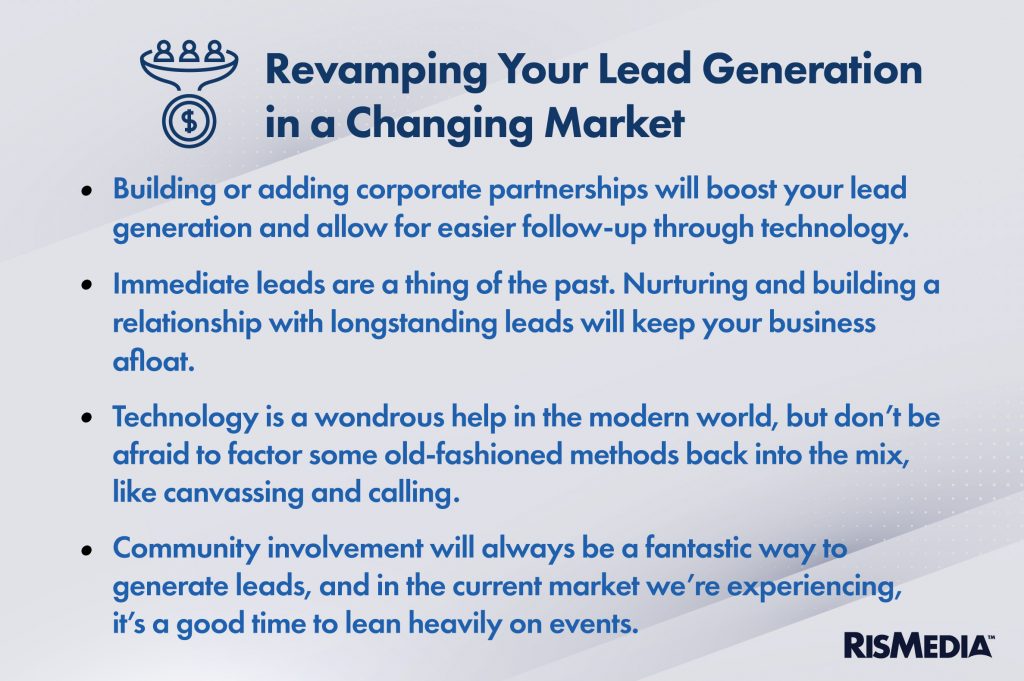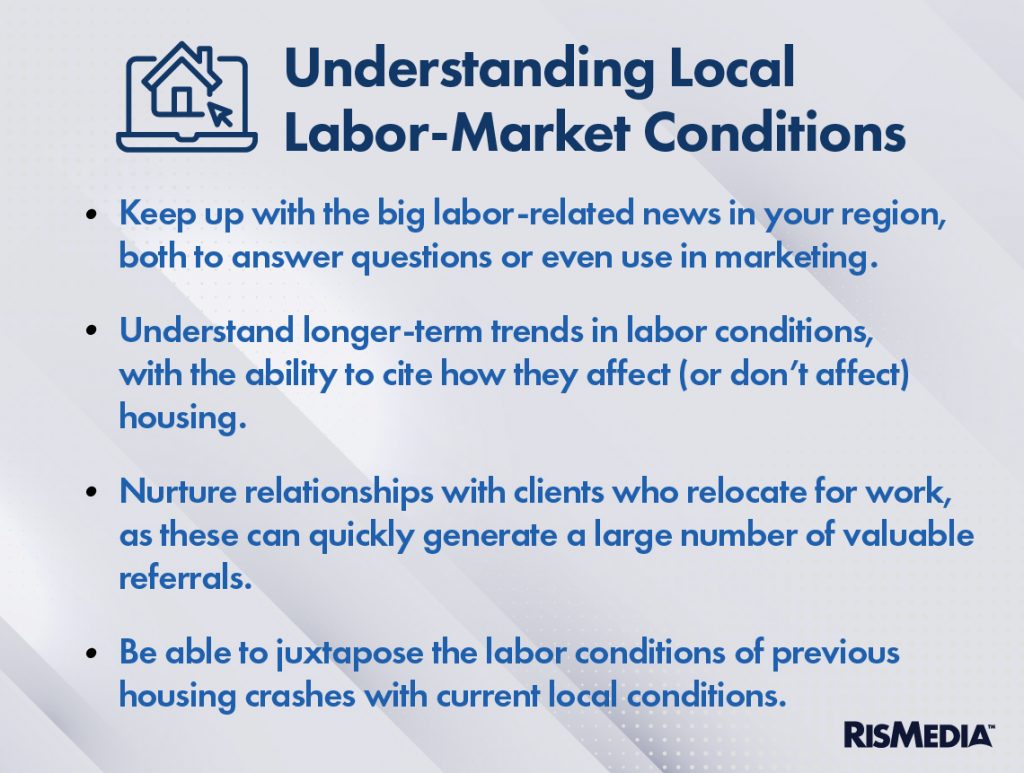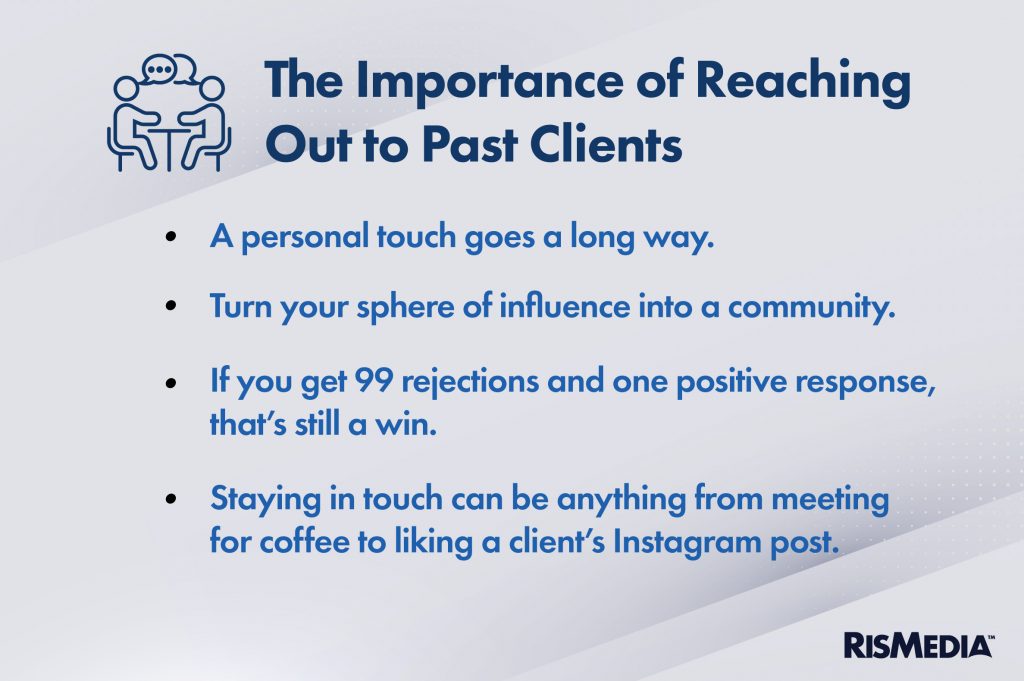Turning Conversations Into Leads, Listings and Clients
There’s not much worse than being trapped in a snore-subject conversation. Like, say, plumbing, traffic or insurance. Lucky for you, most people are delighted to talk about real estate, since they’re either homeowners, renters or, better yet, looking to buy or sell a property. So you’ve chosen a profession that plays well with most anyone you come into contact with.
“My team makes fun of me, but before going to a party or anyone’s home, I’m running comps like it’s an appointment, because real estate always comes up in conversation, and you want to know that market,” says Anthony Friedman, team leader at Northrop Realty, serving Maryland and Washington, D.C.
“And it’s also a good way to learn that market, to know it better than anybody else. Every street, nook and cranny. To know about that community and all the sales. You’re the professional, so if you take care of your clients and give great customer service, others will follow. There’s no need to chase the shiny object and pay for different lead sources. They’re right in front of you.”
Pam Rosser Thistle, a REALTOR® with Berkshire Hathaway HomeServices Fox & Roach, REALTORS® in Philadelphia, takes a different approach when engaging with new people and real estate talk begins. It’s her tried-and-true belief that what goes around comes around.
“I have a vast network of specialists, know strong agents in different markets and readily refer to those agents for the best service,” she explains. “Most are in my phone contacts, so I can share right away when I meet someone in a personal or professional setting. I will answer questions or provide resources. That is how I get a lot of business, by providing resources.
“I’ll talk to someone on the phone for an hour because I want to, or they need me. Not for the business, but it does come around sometimes because people remember. I’m sharing knowledge and cracking misconceptions to save them time.”
Handing out detailed business cards to everyone she meets works for Debbie Lang, a REALTOR® in the New Jersey office of Berkshire Hathaway HomeServices Fox & Roach, REALTORS®.
“I give out cards for the two markets I service,” she notes. “I also have a combined fold-over card with information for both offices on it. My friends and past clients are always recommending me and mentioning me to others they know and even to strangers with a real estate need on social media sites like Nextdoor, Instagram and Facebook.” – Michael Catarevas
Key points
- Researching sales and houses on the market in outlying areas can lead to listings and clients if you converse with people living there.
- Referring information or potential clients to agent contacts closer to them often gets you the same courtesy when they know of people in your area looking for help.
- Handing out business cards is fine, but also try to obtain email/phone contact information for those people so you can follow up with them.
- Tell everyone you know or come into contact with that you’re a REALTOR®, build your database and stay in touch with them.
“I’ll talk to someone on the phone for an hour because I want to, or they need me. Not for the business, but it does come around sometimes because people remember.”
-Pam Rosser Thistle, REALTOR®, Berkshire Hathaway HomeServices Fox & Roach, REALTORS®
To read the full article, click here.
How to Determine When the Listing Price Is Right
Determining the correct listing price for a home is more challenging now than possibly ever before. That’s because 2023 follows a year when the residential real estate market experienced exhilarating highs and numbing lows. Due to rapidly rising mortgage interest rates, the same house in Anytown, USA, might have sold in days for way above list in April, only to sit for weeks with little or no real buyer interest in November.
“All sellers (and buyers) need to adjust as the market shifts,” says Judy Zeder, a REALTOR® with the Jills Zeder Group I Coldwell Banker in Miami, Florida. “What is critically important is that real estate professionals make sure they are current in all activities in the areas they work. They need to study properties coming onto the market, prices that properties are trading at currently (through pendings) and the history of closings. In a fast-paced market, the data may be old in 30 days.”
“We’re in Miami, so there hasn’t been a huge price correction,” notes Minor Ruiz, a real estate professional with Realty ONE Group, Royal Oaks | Miami Lakes, Florida. “We keep getting foreign buyers, plus we have people running away from many of the blue states because of taxes and new corporation laws. The buying or selling client is usually never ready, so we have to explain the process and make them feel positive about their purchase or sale. The more the client is informed, the more comfortable they will feel, and they will trust you for life.”
“My experience so far this year is that it is a lot like the beginning of 2022, with a very serious lack of inventory and bidding wars,” says Debbie Lang, a REALTOR® in the Princeton office of Berkshire Hathaway HomeServices Fox & Roach, REALTORS®. “There are more buyers than there are sellers. People are still waiving appraisals and asking for minimum inspections. Houses are selling over list if the home is in excellent condition and in the right town and location. If there are homeowners thinking about selling, now would be the time to capitalize on the prices that have reached their peak.”
“Real estate is hyperlocal, so home sellers’ demands will vary tremendously in each market,” explains Jerry Pinkas of Jerry Pinkas Real Estate Experts, a brokerage in Myrtle Beach, South Carolina. “Myrtle Beach is experiencing a lot of activity, with many Floridians relocating to the area due to a variety of factors, including reasonable home prices, oceanfront properties and mild weather. Due to the active market, sellers have been able to demand all-cash offers and pre-approved buyers. I am seeing many properties under contract within 48 – 72 hours, regardless of the still-high mortgage rates.”
“House-listing prices this year in Nashville are relatively close to where they capped off at this time last year,” says Amanda Peterson, a REALTOR® with RE/MAX Advantage in Nashville, Tennessee. “Most home sellers are becoming increasingly more understanding of the market change. While typically they come in wanting higher prices, when presented with the data, they understand that pricing correctly is of the essence.” – Michael Catarevas
Key points
- To formulate the right listing price, REALTORS® need to study properties coming onto the market, prices that properties are trading at currently, and the history of closings.
- In slower market areas, sellers need to make their homes as attractive as possible, meaning catering to the whims of potential buyers.
- When a potential seller says they want at least what their neighbor’s house sold for last year, there needs to be a very specific and logical explanation of why this year isn’t last year.
- If an overpriced house languishes on the market, which is usually the case, there will need to be the sometimes difficult discussion about a price reduction.
“Real estate is hyperlocal, so home sellers’ demands will vary tremendously in each market.”
-Jerry Pinkas, Jerry Pinkas Real Estate Experts
To read the full article, click here.
Revamping Your Lead Generation in a Changing Market
Generating leads is one of the most important methods real estate professionals employ to drum up business in the real estate industry. Lead generation is an age-old method when it comes to finding, creating and cultivating client relationships, but with rising mortgage rates and high home prices keeping buyers and sellers out of the market, many lead generation tactics may not be as effective as they used to be.
Change is the only way to survive in a tumultuous market, and that’s what a majority of real estate professionals across the board are doing to maintain success despite the hard times. In order to thrive and generate leads in a market that’s pushing buyers and sellers out, it’s time to make some big adjustments.
Collaboration is a major path to success in any industry, but in the current housing crisis, it has taken on a new level of importance. Partnerships provide the needed support to hold your business together through tough times.
“The key to surviving the shift is partnerships,” says League City, Texas-based Team Founder Monica Foster and Director of Operations and Marketing Christopher Dean, “whether that be corporate (like our team with Zillow, Homeward, etc.) or individual (agents in our collaboration group or upline business partners), where we all work together for a common goal because we all win together. You can’t go it alone, especially if you rely on your sphere, because you can only know so many people—and your sphere can only provide so much.”
Immediate leads have always been the focus in a healthy market, as they would get you business and success quickly, while a longstanding lead may never even turn into a client. This isn’t necessarily true in the current market, as many buyers and sellers are taking their time and waiting out the conditions before they dip their toes in the water.
Tina Caul, REALTOR® and Icon agent in Raleigh, North Carolina, says that for her team, “We are going back to the foundational piece of our business, which is talking to more people each day. We stay in touch for as long as they give permission to keep staying in touch.
“We have clients that took three years to buy, and some that take three days. We are in it for the long haul, and we tell our clients that we believe in great service and know that if we do our job daily by making 20 contacts per day and then following up appropriately, there is never a time that you won’t have business to service.”
Oldies are goodies isn’t just a phrase for music. It can also directly apply to lead generation during the current housing crisis. Technology has pushed the boundaries of the industry, but in a changed market, getting back to the “basics” is an integral part of continuing to generate leads.
“Our team is big on innovation and utilizing technology to grow their audience and prospective clients, however, we also encourage them to go old-school and stick to the basics,” says Kenny Truong of #TEAMFAST with eXp Realty in Oakland, California. “We know that, when leveraged properly, print marketing can work well for brand recognition. For every new listing, we send out 200 Just Listed postcards and encourage our team to door-knock the surrounding neighborhood.”
Nate Cheviron, co-founder and CEO of The Cheviron Group in Indianapolis, Indiana, says that his team’s model is simple, really sticking to the roots of the basics.
“We run a relationship-based model,” he says. “We are more intentional now than ever on doing what we do best: building great relationships with our clients. If there is anything we are cutting out, it’s creative lead generation. Pick up the phone, build great relationships and network to find people who need your help.” – Claudia Larsen
Key points
- Building or adding corporate partnerships will boost your lead generation and allow for easier follow-up through technology.
- Immediate leads are a thing of the past. Nurturing and building a relationship with longstanding leads will keep your business afloat.
- Technology is a wondrous help in the modern world, but don’t be afraid to factor some old-fashioned methods back into the mix, like canvassing and calling.
- Community involvement will always be a fantastic way to generate leads, and in the current market we’re experiencing, it’s a good time to lean heavily on events.
“When leveraged properly, print marketing can work well for brand recognition. For every new listing, we send out 200 Just Listed postcards and encourage our team to door-knock the surrounding neighborhood.”
-Kenny Truong, #TEAMFAST with eXp Realty
To read the full article, click here.
Understanding Local Labor-Market Conditions
While economists parse out the possibilities of a recession, as a real estate professional, the questions are more practical. What questions will clients have about the local labor market and how it affects their real estate decisions? How can the hiring or firing decisions of companies bring more buyers or sellers to the area? And what can the long-term employment trends tell you about the trajectory of your market?
Not every question or strategy will be relevant to every market. But not knowing the opportunities—or at least the basic facts—about both the industry and the labor market in your area could lead to many missed opportunities.
According to Wendy Dickinson, an agent affiliated with Coldwell Banker in the Charlotte, North Carolina, region, the first thing you can do is know the recent developments—big companies moving in, thriving industries and overall job market health—to help assure jittery buyers that their new home won’t crater in price or fail to sell when they decide to move again.
Amanda Snitker, an agent in Denver, Colorado, also affiliated with Coldwell Banker, says that first-time homebuyers in particular are concerned about the long-term value of their property, which makes up an outsized proportion of their net worth.
“Being able to look at the economy as a whole and how stable it is will help them understand how we can kind of project and estimate what their appreciation will be over five to 10 years,” she explains. “We historically have about a 7% annual appreciation in home values…when we look at it on a neighborhood level, there are a lot of different neighborhoods that respond differently.”
Snitker says she will help buyers estimate the future buyer pool of their home years or even a decade down the line based on the likely demand for that home—something that is often interrelated with job markets.
Dickinson says her company liaisons with various relocation organizations that pass on leads or clients who are bringing employees into the region. Those clients are extra valuable, she explains, because they can quickly snowball into a mountain of referrals within the same company or industry.
“I moved one senior-level person in from one company, and have now moved in 90% of the senior team because of referrals generated directly from one person,” Dickinson says. “Most of the larger companies work with a third-party relocation company…Coldwell Banker has a relationship with the third-party person, and they filter through that way.”
But just getting to know people in various growing industries in your region can pay dividends. A former client who worked in HR for a big company “led to quite a bit of business” says Dickinson, as that person connected her with a number of other folks in their company.
“You build a relationship with somebody, it becomes a very easy transition,” she says. “Obviously they want you to help their teammates who are coming in.”
Understanding the expectations and the emotions—or lack thereof—can help you better serve a relocating, job-oriented client.
“I think the purchase and sale becomes a little less emotional and a little more transactional, because it’s not their choice to either be coming or leaving,” says Dickinson. “There’s a lot of professional things going on with the left hand, and so the right hand is really dependent on you, as a real estate professional in the market, to make sure everything is getting done and their needs are being met. There’s a little bit more of a disconnect than for someone who is local.”
Snitker says that one of the important questions related to jobs for both buyers and sellers—but particularly first-time buyers—is about how a home purchase fits into their broader financial plans. To answer that, you have to have knowledge of the industry as well as local labor markets.
First-time homebuyers are more likely to have tighter margins on their monthly expenses, Snitker adds, and so even smaller fluctuations in a labor market will have an outsized effect on the decisions around buying or selling. While a real estate agent might not be the first person they go to for advice about their careers, an agent can certainly generate a lot of value and trust by providing some expertise around the intersection of career, budget and house. – Jesse Williams
Key Points
- Keep up with the big labor-related news in your region, both to answer questions or even use in marketing.
- Understand longer-term trends in labor conditions, with the ability to cite how they affect (or don’t affect) housing.
- Nurture relationships with clients who relocate for work, as these can quickly generate a large number of valuable referrals.
- Be able to juxtapose the labor conditions of previous housing crashes with current local conditions.
“There’s a lot of professional things going on with the left hand, and so the right hand is really dependent on you, as a real estate professional in the market, to make sure everything is getting done and needs are being met.”
-Wendy Dickinson, agent, Coldwell Banker
To read the full article, click here.
The Importance of Reaching Out to Past Clients
In real estate, the closing of a sale may complete the transaction, but a good agent knows that doesn’t represent the end of the client relationship. As many as 82% of all real estate transactions come from referrals and repeat business. That means you should think of everyone you’ve done business with, or even just met in the course of your business, as your sphere of influence.
Jeffrey Goodman, a New York City-based real estate salesperson with Brown Harris Stevens, concurs. He has a background in marketing and is an expert on networking and applying those principles to his business.
“A network is more about maintaining and increasing the value of the social capital you’ve already developed and not just making new connections,” he says.
Here are tips for building a network of clients old and new, and creating a thriving real estate business in the process. The most essential part of building your network is demonstrating why you’re a valuable contact. That means giving your clients the best possible home-buying or -selling experience.
Tony Mattar, a REALTOR® with Compass’ Chicago Crib Team, says: “The nice thing about our industry is that we’re able to rely on the work we’ve already done to make connections.”
He does this by setting standards for communication throughout the sales process.
“I’ll say, ‘This is how we’re going to support you, and what we need from you is open and honest communication. We need that feedback from our clients.’ That typically leads to a conversation of what their expectations are, how they like to be communicated with, how quickly they expect a response and also setting those boundaries for our team because we don’t want to work 24/7.”
The best way to build any relationship is to demonstrate a consistent interest in the other party. This will also ease a lot of the awkwardness of checking in; it’s much easier to reconnect with someone if you last spoke to them a few weeks ago versus two years ago.
Dana Green, CEO of the Dana Green Team in Lafayette, California, lists some questions agents should ask themselves once the transaction is over: “Are you going to be friends? Are you going to meet for coffee? Are you going to connect over something you both like? And after the first month, it’s just consistency.”
As for how to turn these relationships into business assets, Green explains: “We ask all our clients to become our friends on social media and also our eyes and ears in the community. Anytime you see a moving truck, let us know.”
Mattar shares the method he and his team use for keeping up with everyone: “We have a comprehensive, year-long marketing plan that goes to our whole sphere of influence, so that includes past clients, current clients, our friends and families, even people we know who may not be clients.”
So, what do you do if you have let a former client relationship go silent? Mattar says overcoming this is contingent on acknowledgement of it and, in turn, a change of mindset.
“The fear of rejection is omnipresent in everyone’s brain whether you’re a salesperson or not,” he says. They’re going to wonder why I’m reaching out. I try to coach my team on a mindset: people want to be thought of and reached out to. Think about putting yourself in that person’s shoes. If someone you haven’t seen in a couple years reaches out, that makes you feel warm and fuzzy.”
And if you do get a rejection (or a dozen of them), big deal. “With direct mail, if you send out a direct mailer and pay for print and postage, and you get a 2% open rate, that’s excellent,” says Goodman. “Three percent is like a grand slam.” – Devin Meenan
Key points
- A personal touch goes a long way.
- Turn your sphere of influence into a community.
- If you get 99 rejections and one positive response, that’s still a win.
- Staying in touch can be anything from meeting for coffee to liking a client’s Instagram post.
“We have a comprehensive, year-long marketing plan that goes to our whole sphere of influence, so that includes past clients, current clients, our friends and families, even people we know who may not be clients.”
-Tony Mattar, REALTOR®, Compass’ Chicago Crib Team
To read the full article, click here.








